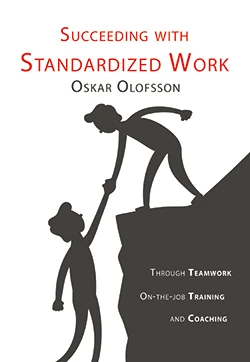
Are you using the Lean-thinking in your sales organization?
Probably not. Within most companies, the sales organization is living its life outside of the regular operation.
Often you hear comments like:
“Every customer is unique, that is why making a sale is not a process that can be improved but rather an art.”
Instead of work for improvement you hope that bonuses will encourage the sales staff to perform miracles.
Until now I have tried to avoid forcing the Lean-methods onto sales people. My thinking has been that sales and marketing hardly contribute to the customer value in itself. Without customer value, there is no way for improvement with the traditional Lean-thinking.
But how does it look?
Investing in a heat pump made me reconsider
This winter we installed a heat pump in our house. A wise investment that we had been planning for some years.
Every winter up till now I have done some research trying to come up with the very best solution for us. On the internet, I have found a few models that seemed both good and cheap. Despite that, I never pressed the “buy” button. I have been unsure if it really will be a good fit for our house.
The difference this time was that a seller contacted me and offered to come to our house. He looked at it and after some discussion we agreed on a solution. He told us about the cost and that we could get an installment next week and a beneficial financing.
Despite the cost being higher than in my researches, we were very happy.
Obviously the seller added some value to the buy since I was glad to pay a bit extra and still be content afterward. But what exactly was the added value?
What hit me was that the value he contributed with was knowledge. Not just information in the form of a pamphlet, but personally adjusted information for me that saved me time and made me feel secure with the purchase.
After that, I got to thinking. If sales and marketing contribute to customer value, there is suddenly no reason not to start thinking Lean within this area as well. Suddenly applying the Lean-principles to sales is an excellent choice!
Womack & Jones have defined five well known Lean principles. To show what I am talking about, I am going to use these principles.
Principle one: Define what creates value from a customer perspective.
This principle was easy. The value of the sales process is knowledge that makes the buying process easier for the customer. Everything that increases knowledge when it is required is valuable, everything else is worthless.
Principle two: Identify and map out all of the steps in the process.
Just like when we use Lean with other disciplines we map out the process. In this case we map out how we will identify the customers need of knowledge depending on where in the buying process the customer is at, and how we deliver that knowledge so the customer will fully understand it.
Does everything add value? Are there any bottlenecks or loops along the way?
Principle three: Make those processes flow.
The goal is to minimize the time from the identification of a need for knowledge to the delivery of the appropriate information. For example, it could be how effective we are when it comes to answering questions from customers or how long time it takes to make an offer.
Tools for creating a good flow could be to visualize the process and even out the workload through better resource management, teamwork, and planning.
Remember that it is not only our time we should minimize but also to avoid wasting the customers time.
Principle four: Only manufacture what is requested.
We will create a pull flow in the sales process by avoiding sending out information that has not yet been requested. For example, we should not write offers that have not been discussed in person. Instead, we need to identify the triggers for when the customer will need more information and has taken a step in the buying process.
Principle five: Strive towards perfection by always minimizing waste.
To find out how we are doing, we need to measure everything in the process. (Sales numbers alone will not be enough since they only show up when it is too late.)
We will create standards and start to see deviations as an important input in the work for improvement. By always following up we can test out new ideas quickly and forget about the things that do not work.
The key to Lean within sales is not to turn the sales people into robots that treat every customer exactly alike. Instead, the goal is to free as much time as possible for the sales staff so that they can do what they do best.
Sellers should meet the customers face to face as much as possible to be able to give them information about the products when it is requested.
By Oskar Olofsson

Making lean work for you

World-Class / Lean Manufacturing

5S Implementation

SMED Quick Change-over

TPM and Plant Maintenance

Succeeding With Standardized Work

Succeeding With 5S